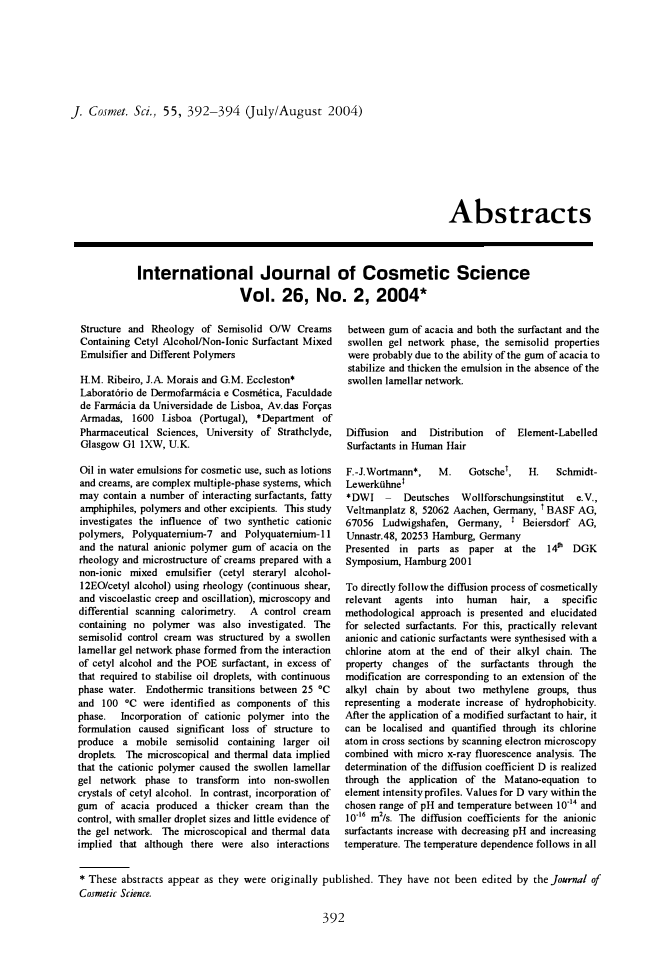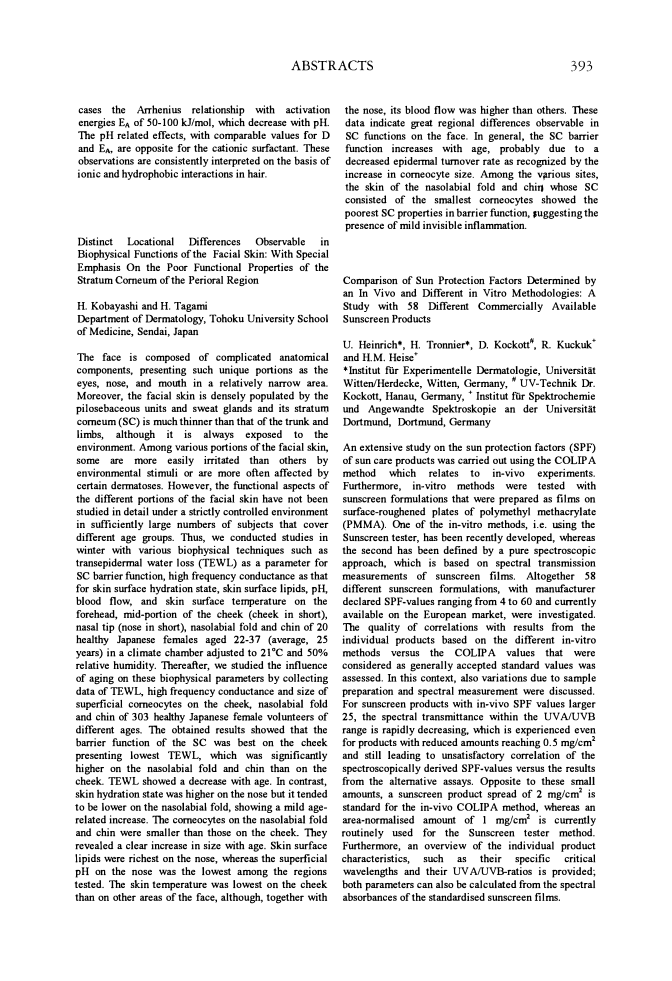J. Cosmet. Sci., 55, 392-394 (July/August 2004) Abstracts International Journal of Cosmetic Science Vol. 26, No. 2, 2004* Structure and Rheology of Semisolid O/W Creams Containing Cetyl Alcohol/Non-Ionic Surfactant Mixed Emulsifier and Different Polymers between gum of acacia and both the surfactant and the swollen gel network phase, the semisolid properties were probably due to the ability of the gum of acacia to stabilize and thicken the emulsion in the absence of the H.M. Ribeiro, J.A Morais and G.M. Eccleston* swollen lamellar network. Laborat6rio de Dermofarmacia e Cosmetica, Faculdade de Fanruicia da Universidade de Lisboa, Av.das For�as Armadas, 1600 Lisboa (Portugal), *Department of Pharmaceutical Sciences, University of Strathclyde, Diffusion and Distribution of Element-Labelled Glasgow Gl lXW, U.K. Surfactants in Human Hair Oil in water emulsions for cosmetic use, such as lotions and creams, are complex multiple-phase systems, which may contain a number of interacting surfactants, fatty amphiphiles, polymers and other excipients. This study investigates the influence of two synthetic cationic polymers, Polyquatemium-7 and Polyquaternium-11 and the natural anionic polymer gum of acacia on the rheology and microstructure of creams prepared with a non-ionic mixed emulsifier (cetyl steraryl alcohol- 12EO/cetyl alcohol) using rheology (continuous shear, and viscoelastic creep and oscillation), microscopy and differential scanning calorimetry. A control cream containing no pol ym er was also investigated. The semisolid control cream was structured by a swollen lamellar gel network phase formed from the interaction of cetyl alcohol and the POE surfactant, in excess of that required to stabilise oil droplets, with continuous phase water. Endothermic transitions between 25 °C and 100 °C were identified as components of this phase. Incorporation of cationic polymer into the formulation caused significant loss of structure to produce a mobile semisolid containing larger oil droplets. The microscopical and thermal data implied that the cationic pol ym er caused the swollen lamellar gel network phase to transform into non-swollen crystals of cetyl alcohol. In contrast, incorporation of gum of acacia produced a thicker cream than the control, with smaller droplet sizes and little evidence of the gel network. The microscopical and thermal data implied that although there were also interactions F.-J.Wortmann*, M. Gotsche\ H. Schmidt- Lewerkiihnet * DWI - Deutsches W ollforschungsinstitut e. V., Veltmanplatz 8, 52062 Aachen, Germany, t BASF AG, 67056 Ludwigshafen, Germany, t Beiersdorf AG, Unnastr.48, 20253 Hamburg, Germany Presented in parts as paper at the 14Jh DGK Symposium, Hamburg 2001 To directly follow the diffusion process of cosmetically relevant agents into human hair, a specific methodological approach is presented and elucidated for selected surfactants. For this, practically relevant anionic and cationic surfactants were synthesised with a chlorine atom at the end of their alkyl chain. The property changes of the surfactants through the modification are corresponding to an extension of the alkyl chain by about two methylene groups, thus representing a moderate increase of hydrophobicity. After the application of a modified surfactant to hair, it can be localised and quantified through its chlorine atom in cross sections by scanning electron microscopy combined with micro x-ray fluorescence analysis. The determination of the diffusion coefficient D is realized through the application of the Matano-equation to element intensity profiles. Values for D vary within the chosen range of pH and temperature between 10· 14 and 10" 16 m 2 /s. The diffusion coefficients for the anionic surfactants increase with decreasing pH and increasing temperature. The temperature dependence follows in all * These abstracts appear as they were originally published. They have not been edited by the Journal of Cosmetic Science. 392
ABSTRACTS 393 cases the Arrhenius relationship with activation energies EA of 50-100 kJ/mol, which decrease with pH. The pH related effects, with comparable values for D and EA, are opposite for the cationic surfactant. These observations are consistently interpreted on the basis of ionic and hydrophobic interactions in hair. Distinct Locational Differences Observable in Biophysical Functiorts of the Facial Skin: With Special Emphasis On the Poor Functional Properties of the Stratum Corneum of the Perioral Region H. Kobayashi and H. Tagami Department of Dermatology, Tohoku University School of Medicine, Sendai, Japan The face is composed of complicated anatomical components, presenting such unique portions as the eyes, nose, and mouth in a relatively narrow area. Moreover, the facial skin is densely populated by the pilosebaceous units and sweat glands and its stratum comeum (SC) is much thinner than that of the trunk and limbs, although it is always exposed to the environment. Among various portions of the facial skin, some are more easily irritated than others by environmental stimuli or are more often affected by certain dermatoses. However, the functional aspects of the different portions of the facial skin have not been studied in detail under a strictly controlled environment in sufficiently large numbers of subjects that cover different age groups. Thus, we conducted studies in winter with various biophysical techniques such as transepidermal water loss (TEWL) as a parameter for SC barrier function, high frequency conductance as that for skin surface hydration state, skin surface lipids, pH, blood flow, and skin surface temperature on the forehead, mid-portion of the cheek (cheek in short), nasal tip (nose in short), nasolabial fold and chin of 20 healthy Japanese females aged 22-37 (average, 25 years) in a climate chamber adjusted to 21 ° C and 50% relative humidity. Thereafter, we studied the influence of aging on these biophysical parameters by collecting data of TEWL, high frequency conductance and size of superficial comeocytes on the cheek, nasolabial fold and chin of 303 healthy Japanese female volunteers of different ages. The obtained results showed that the barrier function of the SC was best on the cheek presenting lowest TEWL, which was significantly higher on the nasolabial fold and chin than on the cheek. TEWL showed a decrease with age. In contrast, skin hydration state was higher on the nose but it tended to be lower on the nasolabial fold, showing a mild age related increase. The comeocytes on the nasolabial fold and chin were smaller than those on the cheek. They revealed a clear increase in size with age. Skin surface lipids were richest on the nose, whereas the superficial pH on the nose was the lowest among the regions tested. The skin temperature was lowest on the cheek than on other areas of the face, although, together with the nose, its blood flow was higher than others. These data indicate great regional differences observable in SC functions on the face. In general, the SC barrier function increases with age, probably due to a decreased epidermal turnover rate as recognized by the increase in comeocyte size. Among the Vf1rious sites, the skin of the nasolabial fold and chill whose SC consisted of the smallest corneocytes showed the poorest SC properties in barrier function, Juggesting the presence of mild invisible inflammation. Comparison of Sun Protection Factors Determined by an In Vivo and Different in Vitro Methodologies: A Study with 58 Different Commercially Available Sunscreen Products U. Heinrich*, H. Tronnier*, D. Kockott11, R. Kuckuk + and HM. Heise+ *Institut fur Experimentelle Dermatologie, Universitiit Witten/Herdecke, Witten, Germany, 11 UV-Technik Dr. Kockott, Hanau, Germany, + lnstitut fur Spektrochemie und Angewandte Spektroskopie an der Universitiit Dortmund, Dortmund, Germany An extensive study on the sun protection factors (SPF) of sun care products was carried out using the COUP A method which relates to in-vivo experiments. Furthermore, in-vitro methods were tested with sunscreen formulations that were prepared as films on surface-roughened plates of polymethyl methacrylate (PMMA). One of the in-vitro methods, i.e. using the Sunscreen tester, has been recently developed, whereas the second has been defined by a pure spectroscopic approach, which is based on spectral transmission measurements of sunscreen films. Altogether 58 different sunscreen formulations, with manufacturer declared SPF-values ranging from 4 to 60 and currently available on the European market, were investigated. The quality of correlations with results from the individual products based on the different in-vitro methods versus the COUP A values that were considered as generally accepted standard values was assessed. In this context, also variations due to sample preparation and spectral measurement were discussed. For sunscreen products with in-vivo SPF values larger 25, the spectral transmittance within the UV A/UVB range is rapidly decreasing, which is experienced even for products with reduced amounts reaching 0.5 mg/cm2 and still leading to unsatisfactory correlation of the spectroscopically derived SPF-values versus the results from the alternative assays. Opposite to these small amounts, a sunscreen product spread of 2 mg/cm2 is standard for the in-vivo COUP A method, whereas an area-normalised amount of 1 mg/cm2 is currently routinely used for the Sunscreen tester method. Furthermore, an overview of the individual product characteristics, such as their specific critical wavelengths and their UV A/UVB-ratios is provided both parameters can also be calculated from the spectral absorbances of the standardised sunscreen films.
Purchased for the exclusive use of nofirst nolast (unknown) From: SCC Media Library & Resource Center (library.scconline.org)






































































































